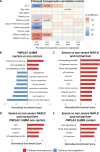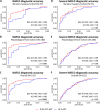Liver transcriptomics highlights interleukin-32 as novel NAFLD-related cytokine and candidate biomarker
- PMID: 32001554
- PMCID: PMC7497582
- DOI: 10.1136/gutjnl-2019-319226
Liver transcriptomics highlights interleukin-32 as novel NAFLD-related cytokine and candidate biomarker
Abstract
Objective: Efforts to manage non-alcoholic fatty liver disease (NAFLD) are limited by the incomplete understanding of the pathogenic mechanisms and the absence of accurate non-invasive biomarkers. The aim of this study was to identify novel NAFLD therapeutic targets andbiomarkers by conducting liver transcriptomic analysis in patients stratified by the presence of the PNPLA3 I148M genetic risk variant.
Design: We sequenced the hepatic transcriptome of 125 obese individuals. 'Severe NAFLD' was defined as the presence of steatohepatitis, NAFLD activity score ≥4 or fibrosis stage ≥2. The circulating levels of the most upregulated transcript, interleukin-32 (IL32), were measured by ELISA.
Results: Carriage of the PNPLA3 I148M variant correlated with the two major components of hepatic transcriptome variability and broadly influenced gene expression. In patients with severe NAFLD, there was an upregulation of inflammatory and lipid metabolism pathways. IL32 was the most robustly upregulated gene in the severe NAFLD group (adjusted p=1×10-6), and its expression correlated with steatosis severity, both in I148M variant carriers and non-carriers. In 77 severely obese, and in a replication cohort of 160 individuals evaluated at the hepatology service, circulating IL32 levels were associated with both NAFLD and severe NAFLD independently of aminotransferases (p<0.01 for both). A linear combination of IL32-ALT-AST showed a better performance than ALT-AST alone in NAFLD diagnosis (area under the curve=0.92 vs 0.81, p=5×10-5).
Conclusion: Hepatic IL32 is overexpressed in NAFLD, correlates with hepatic fat and liver damage, and is detectable in the circulation, where it is independently associated with the presence and severity of NAFLD.
Keywords: cytokines; genetics; nonalcoholic steatohepatitis; rna expression.
© Author(s) (or their employer(s)) 2020. Re-use permitted under CC BY-NC. No commercial re-use. See rights and permissions. Published by BMJ.
Conflict of interest statement
Competing interests: LV reports having received speaking fees from MSD, Gilead, AlfaSigma and AbbVie; having served as a consultant of Gilead, Pfizer, Astra Zeneca and Novo Nordisk; and received research grants from Gilead.
Figures





